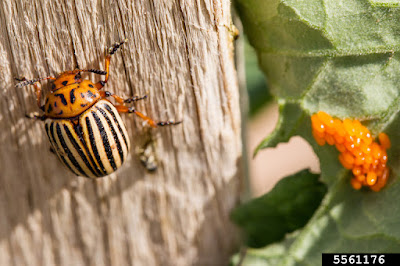Marissa Schuh, Horticulture IPM Extension Educator. Originally published June 7,2023, updated 2024.
Scout to confirm what life stage and size of the Colorado potato beetles on your farm before making any applications. This time of year, we can be seeing adult beetles who have emerged from their winter hiding spots, the eggs they’ve laid, and small larvae. Larvae are the most susceptible life stage to insecticide treatments, and the smaller the larvae are, the better products are going to work. Focus sprays on the small larvae to get good efficacy while also making a dent in potato beetle populations early in the season.
Growers are reporting seeing Colorado potato beetles and their eggs in field. We all know what these guys are capable of, let’s do a rundown of Colorado potato beetle management.
The first flush of Colorado potato beetle activity is the emergence of overwintering adults, who feed and lay eggs. Photo: Jack Rabin, Rutgers NJ Agric. Expt. Station, Bugwood.org.
Non-chemical Controls
- Trials on Minnesota farms have found that flaming, trap crops, and trenching didn’t really work.
- Our old friend row covers can be helpful in protecting very small plants (assuming where you are planting isn’t full of plant debris that are housing overwintering adults).
- Mulches seem to make it harder for adults to reach plants, and for larvae to bury into the soil to pupate.
- Eggs can be squashed, and larvae and beetles can be removed from plants and killed in a variety of emotionally cathartic ways (soapy water, gallon plastic bags left in the sun, I've heard it all).
- There are insects that feed on Colorado potato beetles. It doesn’t seem like they are hungry enough to make a major dent, but they are present doing work. Don’t forget about protecting these insects when using insecticides.
A spotted ladybeetle eating Colorado potato beetle eggs. Photo: Whitney Cranshaw, Colorado State University, Bugwood.org
Using Insecticides
Colorado potato beetle is one tough bug. They’ve handily evolved resistance to over 50 insecticides, and this has happened in Minnesota, on organic farms. Do not rely on just one insecticide in your Colorado potato beetle (*cough* spinosad *cough*), rotate your insecticides. For product recommendations, check out the Midwest Vegetable Production Guide. The guide can quickly give you the modes of actions of different products, so that you can use different products effectively.Scout to confirm what life stage and size of the Colorado potato beetles on your farm before making any applications. This time of year, we can be seeing adult beetles who have emerged from their winter hiding spots, the eggs they’ve laid, and small larvae. Larvae are the most susceptible life stage to insecticide treatments, and the smaller the larvae are, the better products are going to work. Focus sprays on the small larvae to get good efficacy while also making a dent in potato beetle populations early in the season.
Small, recently hatched Colorado potato beetle larvae are the easiest to kill with insecticides. Photo: C. Trouvé, Service de la Protection des Végétaux, Bugwood.org
Depending on what you find, consider treating if...
- 10% leaf defoliation
- Adults: 25 beetles per 50 plants scouted
- Small larvae (about 1/8 inch or less in size): 4 larvae per 50 plants scouted
- Large larvae (closer to .5 inches long): 1.5 larvae per plant or stem, based on a count of 50 plants
These number can shift quickly -- if eggs hatch, for example, the number of larvae on a plant can quadruple. Scout every 3-4 days.
Putting it all together
The below graph gives you at a glance management tactics based on time of year and Colorado potato beetle age.
Graphic and illustrations by Marissa Schuh.

.jpg)
.jpg)
Comments
Post a Comment